But why us?!
Host: Katherine Research Station
Written by Jodie Ward – Pastoral Production Officer, DPIF.
I am regularly told that I have the best job in Australia. I get to travel to a number of cattle stations right across the NT, looking at pasture health on trial sites and sharing my passion for the importance of good rangeland management practices with others. It truly is a great job.
Hi everyone, I am Jodie and I am a Pastoral Production Officer with the Department of Primary Industry and Fisheries based in Katherine. Before completing a degree in Applied Science, I spent a few years working on cattle stations in the NT and QLD as a stationhand. Although I loved the work and being part of a team that became my second family, I came to realise that working in a stockcamp wasn’t for me, so I researched other ways I could remain closely involved in the northern beef industry – and here I am, in the thick of it, loving what I do.
One component of my job that I‘ve been working on lately is assisting the delivery of the Rangeland Management Courses to first and second year ringers on stations across the Barkly and Victoria River districts. Commonly new members of stockcamps have come straight to the NT after finishing school, sometimes with a limited knowledge of cattle production systems or the unique area they now find themselves in (I can certainly say that when I came up to work on Soudan Station at the ripe old age of 17, I definitely fitted into that category!).
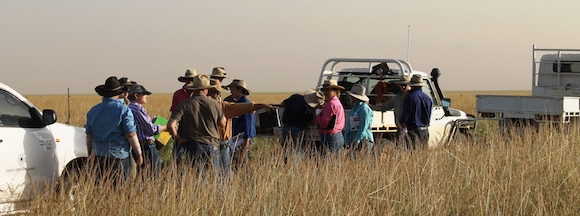 The Anthony Lagoon and Eva Downs stockcamps discussing the value of pasture species found in the area.
The Anthony Lagoon and Eva Downs stockcamps discussing the value of pasture species found in the area.
Typically myself and up to two others will turn up to the station we are delivering the course to the night before, sometimes meeting some of the staff, sometimes not, and spend the rest of the evening fine tuning our presentations and organising logistics for the next day. At this stage I might be starting to feel a little nervous but generally I have things under control, after all, Prior Preparation Prevents P*** Poor Performance! However it is usually just as the course is about to kick off and the stockcamp are taking their seats that my nerves set in and a cold chill consumes my body. For an introvert like me, walking into a room full of strangers where they all know each other and you and your offsider are the only unfamiliar faces in the room, it is a terrifying feeling and usually requires several moments of quiet encouragement before I literally can walk through the door. This fear is however absolutely ridiculous and unsubstantiated as we have never been shown anything but complete kindness and generosity from the people we meet.
So after getting over my initial fear induced paralysis with some laughter and icebreaker activities, we head off into the paddock to discuss the basic principles of rangeland management. Topics we discuss include pasture species identification, the importance of good land condition, weed management, using fire to manage pasture species composition, poisonous plants, and cattle nutrition.
The first two sessions of species identification and land condition are always fun. During species identification, participants collect as many species as they can find and bring them back to the group and share what they know about the plant, including the name of the plant, if it is an annual grass, perennial grass, or a forb, and if they think cattle would eat it. Surprisingly, cattle can be fussy buggers. As a general rule of thumb, cattle have a tendency to graze around plants that are too hairy or prickly, too stalky, too smelly or bitter tasting, which can make the percentage of desirable species in an area unexpectedly small! We then repeat the same exercise close to water and then on a different soil type, encouraging the participants to think about the factors that affect what desirable species grow where and how that affects the number of cattle that can live in that area for an extended period of time.
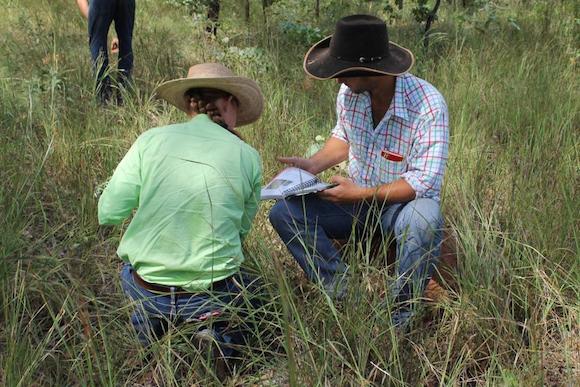 Participants of the Mataranka Rangeland Management Course searching for answers . . .
Participants of the Mataranka Rangeland Management Course searching for answers . . .
We then look at land condition and how areas that have become overgrazed can severely affect the profitability of a station. For example, when an area has been overgrazed for a long period of time and all of the desirable species have been eaten out with no seed bank left in the ground, only undesirable species are left. To turn this degenerated land into something that can be used again can take many years of rest and/or lots of money. We focus on helping participants understand that grass is the most valuable asset on the station. After all, it is pastures that equal pay cheques, cattle are just the converter.
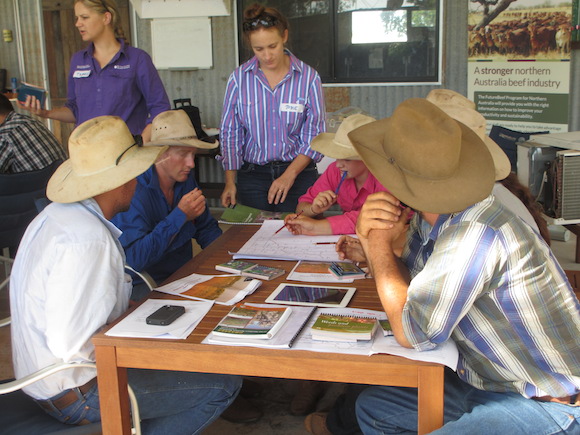 The Camfield, Montejinni, and Delamere Station stockcamps discussing their weed management and prevention strategies.
The Camfield, Montejinni, and Delamere Station stockcamps discussing their weed management and prevention strategies.
At the start of the day we sometimes get a few blank looks of ‘but why are we here? We are only the stockcamp, not managers!’ but we tell them “You guys as stockmen and stockwomen, are the eyes and ears of the station! The manager can’t be everywhere! If there is something going on in the paddock it is likely that you guys on the ground are going to be the one to see it! And if you know what to look out for in terms of weed identification and pasture and animal health, you will notice when something is going wrong! Your knowledge is essential to the successful management of the station!”
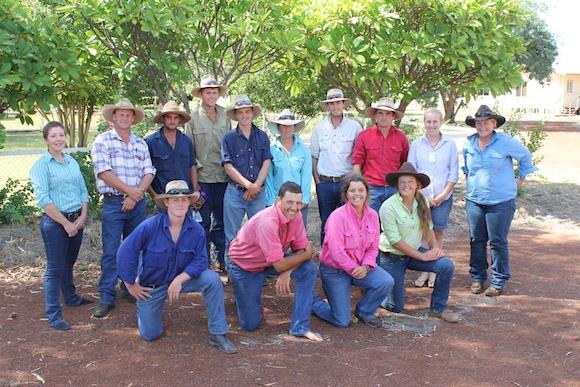 The Anthony Lagoon and Eva Downs proud as punch after ‘designing’ their own cattle stations at the end of the course using the principles they have learnt over the past day and a half.
The Anthony Lagoon and Eva Downs proud as punch after ‘designing’ their own cattle stations at the end of the course using the principles they have learnt over the past day and a half.
Many times we have seen ‘aha!’ moments in our young participants; whether that be related to the distance cattle on the Barkly will graze from water (3-5km), to realising why they have been told not to put dry season lick containing urea close to the trough (urea poisoning ends up in rapid death if eaten then followed immediately by water), and it’s these moments that make me realise why I love my job.
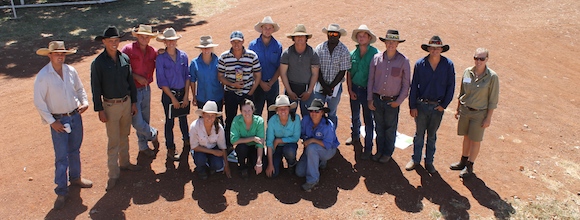 The Brunette stockcamps we visited earlier in the year where we (the presenters!) learnt about the nutritional value of the Bluebush swamps.
The Brunette stockcamps we visited earlier in the year where we (the presenters!) learnt about the nutritional value of the Bluebush swamps.
I enjoy presenting these courses because I believe that by doing so we are helping the participants learn the ‘reason why’ behind the daily tasks they undertake as part of their role, and if a person understands this, they are likely to go about their job more diligently and notice things that don’t look right. As well as this, I enjoy delivering these courses because I hate, with a passion, seeing degraded country – a bit like the ‘birds and the bees’ discussion, I hope that by starting the conversation early and providing them with some facts, some potentially risky trial and error can be avoided!
Palatable, perennial, productive native pastures form the basis of the northern beef industry. They require little to no input yet put kilos on our cattle year in, year out – all we have to do is understand how they tick and we can continue to get the best out of them for the foreseeable future. Because don’t forget, it’s pastures that equal the pay cheques, cattle are just the converter.

